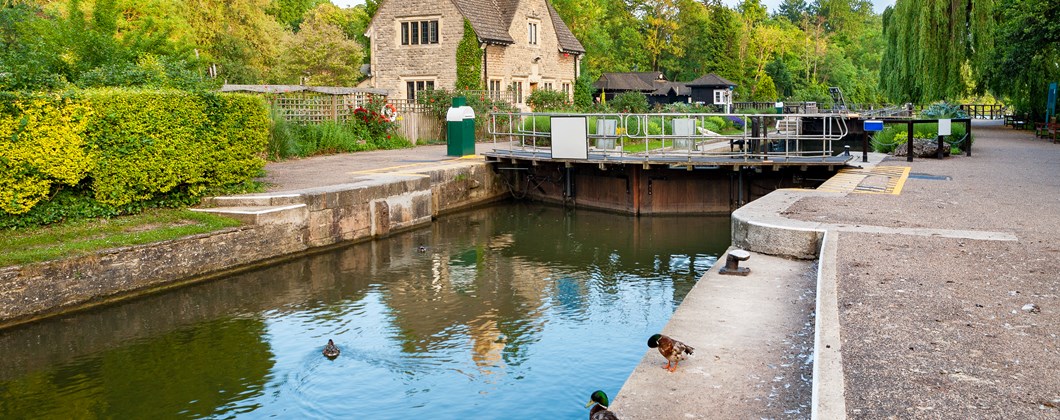Top Tips on Canal Lock Safety

Operating locks can be part of the fun on your canal boating holiday once you get the hang of it. It can be daunting first time round but once you learn the concept of how they work you’ll be confident in no time!
Some locks have gates located at each end, which means they can be used in either direction. Once you’re inside the lock and the gates are closed, water will either empty or fill up the chamber, in order for your narrowboat to get lifted or lowered to match the water level on the next section of the waterway.
On board you should make sure that you have a lock handle or windlass which is a tool that you will need to open and close every lock you pass through.
Lock Safety Tips
- When approaching a lock, unless it is in use, you should find all of the gates shut and all the paddles down. You will need to stop before you enter the lock to allow a crew member to “set” the lock (empty or fill as necessary, and open gates).
- Never open paddles in the top gate and the bottom gate at the same time.
- In the event of an emergency, or if there is any uncertainty about procedure, it is important to close all of the paddles immediately.
- Be sure to have at least one experienced crew member aboard the boat at all times when in the lock.
- Keep an eye on your side fenders. They can get caught up on the lock side or the gates as you pass – particularly in narrow locks.
- When entering a full lock, be sure to avoid the ‘cill’. This is the “doorstep” onto which the top gate closes, and it can only be seen when the lock is empty. Move the boat forward far enough to avoid the stern being caught up as the lock empties.
- Do not tie up the boat to the side of the lock. It may be caught hanging from the side as the lock empties. Rather, loop a rope (ideally from the centre of the boat) around a bollard and pass it back to the helmsman.
- The forces of water involved when operating paddles are tremendous, and cause massive currents in and around the lock, on which the boat’s engine will have no effect. Crew members operating the paddles share responsibility with the helmsman for what happens to the boat in the lock.
- If in doubt, do not open paddles fully until the lock is part full. This will reduce turbulence inside the lock and make the helmsman’s job easier.
- You will find plenty of volunteers willing to help with winding paddles and opening and closing gates. It is important to check that everyone knows what to do, and what order to do it in.
- Lastly, when working around locks, hang on tight and watch your footing.
For more information on how to use a lock on the inland waterways – watch this detailed video.
Different Types of Locks
Single Locks
Single locks usually have three gates: two at the higher end of the lock, which close together in the centre, and one at the lower end which closes across the full width of the canal. They are normally just large enough to accommodate a standard canal narrowboat which is 6 ft 10 in wide and 72 ft long.
Locks are filled and emptied by using a windlass or lock key to wind ‘paddles’, which open and close sluices, allowing water to drain into the lock from above, or out of the lock to the canal below, when all the gates are closed.
Broad Locks
Often called double locks, are usually twice the width of a standard single lock, and can accommodate two narrowboats side-by-side, or a single ‘widebeam’ canal boat.
Double Locks
Or Paired Locks, are normally single locks, built side by side on the canal. They are linked underground by an additional paddle operated sluice. Hence when one lock is full (carrying a boat travelling downhill) and the other empty (carrying a boat going uphill), water can be drained from the full lock to the empty lock, raising one boat and lowering the other at the same time. In this way, moving two boats through two locks is done using only one lockful of water. Water conservation is of vital importance in canal management.
Stop Locks
Were built by the various companies owning and managing the canal system, to mark the beginning or end of their stretch of canal. The company’s responsibility for water management ended at the stop lock at the lower end of their designated waterway. Stop locks were also a way of temporarily halting boats owned by a rival company, so that a toll could be charged for their use of the canal.
Staircase Locks
Frequency of locks is determined by the gradient of the canal, and at its ultimate, the locks follow immediately one after the other. The bottom gates of one lock become the top gates of the next, forming a “staircase”. When navigating a staircase, the flow of water through the entire staircase must be considered, not just entry and exit to and from each lock. On some double width staircases it is possible to see two narrowboats pass each other in opposite directions!
Need Narrowboat Insurance?
Remember that when operating canal locks, ensure that any personal possessions that you are carrying, are in a secure, zipped pocket, or similar, as if these are lost or damaged, they may not be covered under your policy.
For more Narrowboat advice, take a look at our other articles on our blog.
